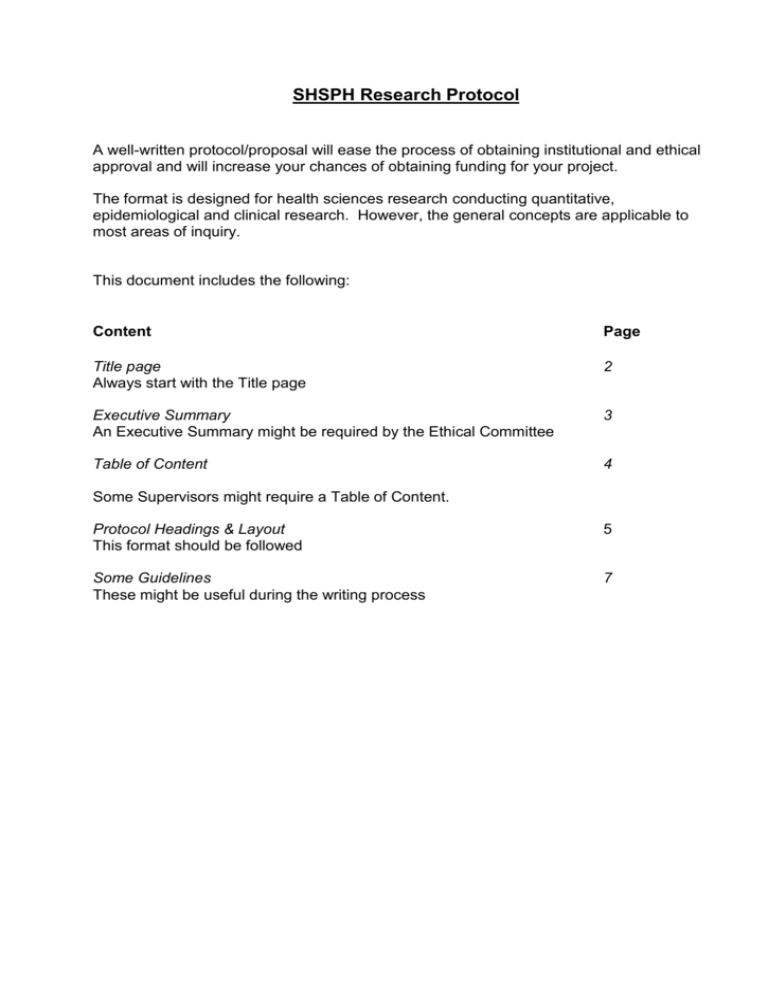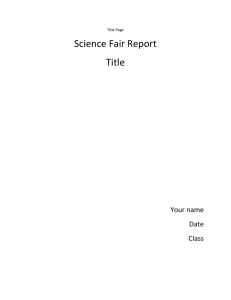SHSPH Research Protocol - University of Pretoria
advertisement

SHSPH Research Protocol A well-written protocol/proposal will ease the process of obtaining institutional and ethical approval and will increase your chances of obtaining funding for your project. The format is designed for health sciences research conducting quantitative, epidemiological and clinical research. However, the general concepts are applicable to most areas of inquiry. This document includes the following: Content Page Title page Always start with the Title page 2 Executive Summary An Executive Summary might be required by the Ethical Committee 3 Table of Content 4 Some Supervisors might require a Table of Content. Protocol Headings & Layout This format should be followed 5 Some Guidelines These might be useful during the writing process 7 University of Pretoria Faculty of Health Sciences School of Health Systems & Public Health Title of the Research Project for the degree (name the degree - if applicable) Author (full name & surname) Student number (if applicable) Contact details: Address: Tel: Fax: Cell: E-mail: Supervisor: (Title, initials, surname) Co-supervisor: (if applicable) Date: 2 Title Executive Summary (as per Ethics Committee guidelines) The following questions must be answered, without including the question: Why is the project necessary? (Introduction) What are you going to do? (Aims) How are you going to do the project? (Methods) What will be the project outputs? What is the projected impact of the project? 3 Table of Content (if required by Supervisor) Include the different headings and subheading as in your protocol. 4 1. Introduction and literature review * Content will be determined according to your protocol, but should include the following: (don’t use as subheadings) Why this subject is important What is known (previous studies) What isn’t known (limitations of previous studies) Historical background What factors lead to and why the research project was initiated The requirements of the institution, patients or circumstances that lead to the research Definition of the problem/hypothesis/research question Justification of your study (based on the above aspects: e.g. importance of subject, gaps in knowledge, request from the institution etc…) 2. Aim(s) and objectives Hypothesis (for analytical studies only) Study objectives 3. Methods 3.1 Study design 3.2 Study Setting 3.3 Study population and sampling 3.3.1 Study population (inclusion and exclusion criteria) 3.3.2 Sampling method 3.3.3 Sampling size 3.4 Measurements - Measurement tools (e.g. clinical examination, questionnaire…) - Measurement methods (detailed description of how measurements will be done) - Variables: list variables here grouped according to exposure and outcome variables if relevant. Detailed description of “case status” or exposure status (if applicable) - Validity and reliability of measurement instrument (if applicable) - Quality control 3.5 Pilot study 4. Data Management and Analysis 5 5. Ethical and legal considerations - Approval of study by the relevant departments - Consent - Privacy of information/confidentiality - Potential harms and benefits - Justic - Conflict of interest 6. Logistics and time schedule - Project management timetable (Action Plan and or Gantt chart) - Responsibilities of staff and/or investigators (Contributors and Authorship) 7. Budget/ Resources - Available resources - Budget and budget motivation 8. Reporting of results 9. References 10. Appendices: - Data collection instrument - Letters of approval - Ethics Consent forms * Protocol headings adapted from Epidemiology , A Research Manual for South Africa. 2 nd Edition. Eds. Joubert and Ehrlich, Oxford University Press Southern Africa 6 Some Guidelines for Writing the Protocol TITLE Step 1: - Selecting the research topic Become aware of the problem Survey of the field Literature study Experimental survey Pilot study Selecting the title of the topic * * * +10 words Concise, limiting, practical, worthwhile and contributes to science. The researcher should see his/her project title as an implicit submission of an economical, but responsible; not easily convincible, but impartial; critical but empathic sponsor; explaining why funds and facilities should be made available for this project and that the project leader will utilize funds accordingly. INTRODUCTION Step 2: - Problem formulation * * * * * * Historical background What factors lead to and why the research project was initiated Identify the problem The requirements of the institution, patients or circumstances that lead to the research The value of the research Not only a literature review LITERATURE STUDY * * * * * Knowledge of other applicable research. Knowledge about the methods. Actuality (topicality) of the research. Define extent, aims or purpose. Relevant updated information. HYPOTHESIS Step 3: * Hypothesis formulation A hypothesis is a provisional and possible explanation for a problem - indicates direction of research 7 * * State a clearly defined hypothesis. What do you expect? AIMS/OBJECTIVES Step 4: * Formulation of objectives It states exactly what is to be achieved To establish the results to be accomplished Quality thoughts precede quality results * * * Short, but complete. Avoid generality. Must be defined: association, method, duration, hypothesis and variables. Work SMARTer not harder: S - specific M - measurable A - attainable R - realistic T - time METHODS * * * * Methods and techniques that are not standard or supported by literature, must be concisely and clearly explained. Make use of schematic representations. Specify study groups - inclusion criteria Statistical methods ADMINISTRATIVE ASPECTS: see protocol headings * * * * Ethical aspects Budget Project team Logistics REFERENCES * * * Correct and complete reference system e.g. Vancouver system Use Refworks for ease of referencing Other software packages, like Reference Manager, will also be helpful. 8 ACTION PLAN * Actions explained completely in diagram. Preparing an action plan: * Identify the need * State a specific objective * Decide how you will know when you have met the specific objective * Express this in a statement of standards * List the program steps necessary to accomplish the specific objective * Fix accountability on individuals * Schedule the beginning and completion of each step * Allocate resources for the accomplishment of your program in a budget * Compare the value of the objective against the cost of achieving it * Establish controls necessary to assure achievement of the objective GANTT CHART * Indicates exact dates that specific actions occur. 9 Example: GANTT CHART ACTIONS Literature study Statistics Ethical aspects Funding Experimental procedures Data processing Statistical analysis Publication preparation Congresses JAN FEB MAR APR MAY JUN JUL AUG SEP OCT NOV DEC Example: ACTION PLAN ACTIONS RESPONSIBLE TIME BUDGET Literature study Statistics Ethical aspects Funding Experimental Procedures *Technique Development *Specimen collection & determination Data file Statistical analysis Publication preparation Congress presentation 11 ACTION SPECIFICATION







